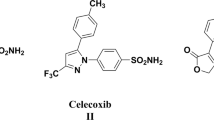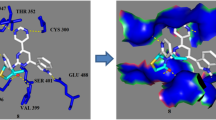Abstract
Bacterial infections continue to present a formidable challenge to human health, prompting intensified research efforts towards the development of effective antibacterial agents. This study harnesses click chemistry techniques to synthesize Isatin-1,2,3-triazole as a novel antibacterial agent, evaluating its in vitro efficacy against prevalent pathogens including Gram-negative (Escherichia coli) and Gram-positive (Staphylococcus aureus) strains using both the microdilution and well-diffusion methods. The findings reveal a notable enhancement in antibacterial activity upon incorporation of the triazole moiety into the Isatin framework against both E. coli and S. aureus. Further analysis, including structure–activity relationship studies and molecular docking investigations, highlights the superior antibacterial potency of triazole-tethered Isatin tosyl azide compared to N-propargyl Isatin. Molecular docking simulations with Staphylococcus aureus (PDB ID: 4TU5) and Escherichia coli (PDB ID: 6YD9) proteins exhibit promising binding affinities of − 10.44 kJ/mol and − 8.4 kJ/mol, respectively. Isatin triazole demonstrates favorable gastrointestinal absorption properties, low toxicity profiles, adherence to Lipinski's rule of five, and compliance with Veber and Ghose standards. Furthermore, molecular dynamics simulations attest to the stability of protein complexes over a 100 ns timeframe. Collectively, these findings underscore the therapeutic potential of Isatin triazole compounds against bacterial infections, warranting further clinical exploration to elucidate their mechanisms of action and therapeutic efficacy.
Graphical Abstract:















Similar content being viewed by others
References
(1996) Infectious diseases kill over 17 million people a year: WHO warns of global crisis. https://www.who.int/news/item/01-01-1996-infectious-diseases-kill-over-17-million-people-a-year-who-warns-of-global-crisis
Dye C (2014) After 2015: infectious diseases in a new era of health and development. Philos Trans Royal Soc B: Biol Sci 369:20130426
Marepu N, Yeturu S, Pal M (2018) 1,2,3-Triazole fused with pyridine/pyrimidine as new template for antimicrobial agents: Regioselective synthesis and identification of potent N-heteroarenes. Bioorg Med Chem Lett 28:3302–3306. https://doi.org/10.1016/j.bmcl.2018.09.021
Hu YQ, Zhang S, Xu Z et al (2017) 4-Quinolone hybrids and their antibacterial activities. Eur J Med Chem 141:335–345. https://doi.org/10.1016/j.ejmech.2017.09.050
Yadav N, Mudgal D, Mishra A et al (2024) Harnessing fluorescent carbon quantum dots from natural resource for advancing sweat latent fingerprint recognition with machine learning algorithms for enhanced human identification. PLoS ONE 19:e0296270. https://doi.org/10.1371/journal.pone.0296270
Yadav N, Mudgal D, Mishra S et al (2023) Development of ionic liquid-capped carbon dots derived from Tecoma stans (L.) Juss. ex Kunth: Combatting bacterial pathogens in diabetic foot ulcer pus swabs, targeting both standard and multi-drug resistant strains. S Afr J Bot 163:412–426. https://doi.org/10.1016/j.sajb.2023.10.063
Ivasiv V, Albertini C, Gonçalves AE et al (2019) Molecular hybridization as a tool for designing multitarget drug candidates for complex diseases. Curr Top Med Chem 19:1694–1711
Singh H, Singh JV, Gupta MK et al (2017) Triazole tethered isatin-coumarin based molecular hybrids as novel antitubulin agents: Design, synthesis, biological investigation and docking studies. Bioorg Med Chem Lett 27:3974–3979. https://doi.org/10.1016/j.bmcl.2017.07.069
Kumar M, Verma S, Mishra V et al (2022) Visible-Light-Accelerated Copper-Catalyzed [3+ 2] Cycloaddition of N-Tosylcyclopropylamines with Alkynes/Alkenes. J Org Chem 87:6263–6272. https://doi.org/10.1021/acs.joc.2c00491
Ngo HL, Mishra DK, Mishra V, Truong CC (2021) Recent advances in the synthesis of heterocycles and pharmaceuticals from the photo/electrochemical fixation of carbon dioxide. Chem Eng Sci 229:116142. https://doi.org/10.1016/j.ces.2020.116142
Chatterjee S, Mishra V (2020) Green chemistry–Remedy to societal hygiene: a graphical review. Curr Res Gr Sustain Chem 3:100025. https://doi.org/10.1016/j.crgsc.2020.100025
Yadav N, Mudgal D, Mishra V (2023) In-situ synthesis of ionic liquid-based-carbon quantum dots as fluorescence probe for hemoglobin detection. Anal Chim Acta 1272:341502. https://doi.org/10.1016/j.aca.2023.341502
Mudgal D, Singh RP, Yadav N, Mishra V (2023) Exploring the catalytic efficiency of copper-doped Magnetic carbon aerogel towards the coupling reaction of Isatin oxime with Phenylboronic acid derivatives. SynOpen 7:570–579. https://doi.org/10.1055/a-2182-7757
Laurent A (1840) Recherches sur l’indigo. Ann Chim Phys 3:393–434
Erdmann OL (1840) Untersuchungen über den Indigo. J Prakt Chem 19:321–362
Lan Y, Zou Y, Huang T et al (2016) Indole methylation protects diketopiperazine configuration in the maremycin biosynthetic pathway. Sci China Chem 59:1224–1228. https://doi.org/10.1007/s11426-016-0026-7
Meleddu R, Petrikaite V, Distinto S et al (2019) Investigating the anticancer activity of Isatin/Dihydropyrazole Hybrids. ACS Med Chem Lett 10:571–576. https://doi.org/10.1021/acsmedchemlett.8b00596
Bhagat K, Bhagat J, Gupta MK et al (2019) Design, synthesis, antimicrobial evaluation, and molecular modeling studies of novel indolinedione-coumarin molecular hybrids. ACS Omega 4:8720–8730. https://doi.org/10.1021/acsomega.8b02481
Abo-Ashour MF, Eldehna WM, George RF et al (2018) Novel indole-thiazolidinone conjugates: design, synthesis and whole-cell phenotypic evaluation as a novel class of antimicrobial agents. Eur J Med Chem 160:49–60. https://doi.org/10.1016/j.ejmech.2018.10.008
Ma JY, Quan YC, Jin HG et al (2016) Practical synthesis, antidepressant, and anticonvulsant activity of 3-Phenyliminoindolin-2-one derivatives. Chem Biol Drug Des 87:342–351. https://doi.org/10.1111/cbdd.12668
Meleddu R, Distinto S, Corona A et al (2015) (3Z)-3-(2-[4-(aryl)-1,3-thiazol-2-yl]hydrazin-1-ylidene)-2,3-dihydro- 1H -indol-2-one derivatives as dual inhibitors of HIV-1 reverse transcriptase. Eur J Med Chem 93:452–460. https://doi.org/10.1016/j.ejmech.2015.02.032
Kumar S, Bains T, Won Kim AS et al (2018) Highly potent 1H–1,2,3-triazole-tethered isatin-metronidazole conjugates against anaerobic foodborne, waterborne, and sexually-transmitted protozoal parasites. Front Cell Infect Microbiol 8:2–10. https://doi.org/10.3389/fcimb.2018.00380
Wang G, Chen M, Qiu J et al (2018) Synthesis, in vitro α-glucosidase inhibitory activity and docking studies of novel chromone-isatin derivatives. Bioorg Med Chem Lett 28:113–116. https://doi.org/10.1016/j.bmcl.2017.11.047
Xu Z, Zhang S, Song X et al (2017) Design, synthesis and in vitro anti-mycobacterial evaluation of gatifloxacin-1H-1,2,3-triazole-isatin hybrids. Bioorg Med Chem Lett 27:3643–3646. https://doi.org/10.1016/j.bmcl.2017.07.023
Xu Z, Song XF, Hu YQ et al (2017) Azide-alkyne cycloaddition towards 1H–1,2,3-triazole-tethered gatifloxacin and isatin conjugates: Design, synthesis and in vitro anti-mycobacterial evaluation. Eur J Med Chem 138:66–71. https://doi.org/10.1016/j.ejmech.2017.05.057
Song F, Li Z, Bian Y et al (2020) Indole/isatin-containing hybrids as potential antibacterial agents. Arch Pharm (Weinheim) 353:2000143
Kolb HC, Sharpless KB (2003) The growing impact of click chemistry on drug discovery. Drug Discov Today 8:1128–1137
Liang L, Astruc D (2011) The copper(I)-catalyzed alkyne-azide cycloaddition (CuAAC) “click” reaction and its applications. An overview Coord Chem Rev 255:2933–2945. https://doi.org/10.1016/j.ccr.2011.06.028
Mishra V, Kumar R (2019) Cyclic polymer of N-vinylpyrrolidone via ATRP protocol: kinetic study and concentration effect of polymer on click chemistry in solution. Polym Sci Ser B 61:753–761. https://doi.org/10.1134/S1560090419060095
Mishra V, Kumar R (2011) RAFT polymerization of N-vinyl pyrrolidone using prop-2-ynyl morpholine-4-carbodithioate as a new chain transfer agent. J Appl Polym Sci 124:4475–4485. https://doi.org/10.1002/app.35480
Mishra V, Jung S-H, Jeong HM, Lee H (2014) Thermoresponsive ureido-derivatized polymers: the effect of quaternization on UCST properties. Polym Chem 5:2411–2416. https://doi.org/10.1039/C3PY01648J
Yadav N, Gaikwad RP, Mishra V, Gawande MB (2022) Synthesis and photocatalytic applications of functionalized carbon quantum dots. Bull Chem Soc Jpn 95:1638–1679. https://doi.org/10.1246/bcsj.20220250
Kumar A, Yadav AK, Mishra V, Kumar D (2023) Recent Advancements in triazole-based click chemistry in cancer drug discovery and development. SynOpen 7:186–208. https://doi.org/10.1055/s-0042-1751452
Nuzzi A, Massi A, Dondoni A (2007) Model studies toward the synthesis of thymidine oligonucleotides with triazole internucleosidic linkages via iterative Cu (I)-promoted azide–alkyne ligation chemistry. QSAR Comb Sci 26:1191–1199
Yadav N, Mudgal D, Anand R et al (2022) Recent development in nanoencapsulation and delivery of natural bioactives through chitosan scaffolds for various biological applications. Int J Biol Macromol 220:537–572. https://doi.org/10.1016/j.ijbiomac.2022.08.098
Miljanić OŠ, Dichtel WR, Aprahamian I et al (2007) Rotaxanes and catenanes by click chemistry. QSAR Comb Sci 26:1165–1174. https://doi.org/10.1002/qsar.200740070
Kraljević TG, Harej A, Sedić M et al (2016) Synthesis, in vitro anticancer and antibacterial activities and in silico studies of new 4-substituted 1,2,3-triazole–coumarin hybrids. Eur J Med Chem 124:794–808. https://doi.org/10.1016/j.ejmech.2016.08.062
Riveiro ME, Moglioni A, Vazquez R et al (2008) Structural insights into hydroxycoumarin-induced apoptosis in U-937 cells. Bioorg Med Chem 16:2665–2675. https://doi.org/10.1016/j.bmc.2007.11.038
Ostrov DA, Hernández Prada JA, Corsino PE et al (2007) Discovery of novel DNA gyrase inhibitors by high-throughput virtual screening. Antimicrob Agents Chemother 51:3688–3698. https://doi.org/10.1128/AAC.00392-07
Gali R, Banothu J, Gondru R et al (2015) One-pot multicomponent synthesis of indole incorporated thiazolylcoumarins and their antibacterial, anticancer and DNA cleavage studies. Bioorg Med Chem Lett 25:106–112. https://doi.org/10.1016/j.bmcl.2014.10.100
Arshad A, Osman H, Bagley MC et al (2011) Synthesis and antimicrobial properties of some new thiazolyl coumarin derivatives. Eur J Med Chem 46:3788–3794
Joao Matos M, Vazquez-Rodriguez S, Santana L et al (2012) Looking for new targets: simple coumarins as antibacterial agents. Med Chem (Los Angeles) 8:1140–1145. https://doi.org/10.2174/1573406411208061140
Shi Y, Zhou CH (2011) Synthesis and evaluation of a class of new coumarin triazole derivatives as potential antimicrobial agents. Bioorg Med Chem Lett 21:956–960. https://doi.org/10.1016/j.bmcl.2010.12.059
Mishra V, Jung S, Park JM et al (2014) Triazole-containing hydrogels for time-dependent sustained drug release. Macromol Rapid Commun 35:442–446. https://doi.org/10.1002/marc.201300585
Chatterjee S, Kumar N, Sehrawat H et al (2021) Click triazole as a linker for drug repurposing against SARs-CoV-2: a greener approach in race to find COVID-19 therapeutic. Curr Res Gr Sustain Chem 4:100064. https://doi.org/10.1016/j.crgsc.2021.100064
Gao F, Ye L, Kong F et al (2019) Design, synthesis and antibacterial activity evaluation of moxifloxacin-amide-1,2,3-triazole-isatin hybrids. Bioorg Chem 91:103162. https://doi.org/10.1016/j.bioorg.2019.103162
Zhang B (2019) Comprehensive review on the anti-bacterial activity of 1,2,3-triazole hybrids. Eur J Med Chem 168:357–372. https://doi.org/10.1016/j.ejmech.2019.02.055
Chen QY, Wang Q (2015) A facile and effective route to the synthesis of sulfonyl azides. Adv Mat Res 1094:7–10. https://doi.org/10.4028/www.scientific.net/amr.1094.7
Sulmiyati SN, Fahrodi DU et al (2019) Assessment of the antibacterial activity of goat milk kefir on Escherichia coli ATCC 8739 and Salmonella enteric subsp. enterica serovar typhimurium ATCC 14028 using a well diffusion method. IOP Conf Ser Earth Environ Sci. https://doi.org/10.1088/1755-1315/247/1/012051
Berman HM, Westbrook J, Feng Z et al (2000) The protein data bank. Nucleic Acids Res 28:235–242
Morris GM, Huey R, Lindstrom W et al (2009) AutoDock4 and AutoDockTools4: automated docking with selective receptor flexibility. J Comput Chem 30:2785–2791
DeLano WL (2002) Pymol: an open source molecular graphics tool. CCP4 Newsl Protein Crystallogr 40:82–92
Studio D (2008) Discovery studio. Accelrys [21]
Kumar D, Kumar R, Ramajayam R et al (2021) Synthesis, antioxidant and molecular docking studies of (-)-catechin derivatives. J Korean Chem Soc 65:106–112
Cousins KR (2011) Computer review of ChemDraw ultra 12.0
Dallakyan S, Olson AJ (2015) Small-molecule library screening by docking with PyRx. Chemical biology. Humana Press, New York, NY.pp 243–250.https://doi.org/10.1007/978-1-4939-2269-7_19
Sandeep G, Nagasree KP, Hanisha M, Kumar MMK (2011) AUDocker LE: a GUI for virtual screening with AUTODOCK Vina. BMC Res Notes 4:1–4
Daina A, Michielin O, Zoete V (2017) SwissADME: a free web tool to evaluate pharmacokinetics, drug-likeness and medicinal chemistry friendliness of small molecules. Sci Rep 7:1–13
Kar S, Leszczynski J (2020) Open access in silico tools to predict the ADMET profiling of drug candidates. Expert Opin Drug Discov 15:1473–1487
Dash AK, Mukherjee D, Dhulap A et al (2019) Green chemistry appended synthesis, metabolic stability and pharmacokinetic assessment of medicinally important chromene dihydropyrimidinones. Bioorg Med Chem Lett 29:126750
Bowers KJ, Chow E, Xu H, et al (2006) Scalable algorithms for molecular dynamics simulations on commodity clusters. Proceedings of the 2006 ACM/IEEE Conference on Supercomputing, SC’06. https://doi.org/10.1145/1188455.1188544
Madhavi Sastry G, Adzhigirey M, Day T et al (2013) Protein and ligand preparation: Parameters, protocols, and influence on virtual screening enrichments. J Comput Aided Mol Des 27:221–234. https://doi.org/10.1007/S10822-013-9644-8/TABLES/9
Shivakumar D, Williams J, Wu Y et al (2010) Prediction of absolute solvation free energies using molecular dynamics free energy perturbation and the opls force field. J Chem Theory Comput 6:1509–1519. https://doi.org/10.1021/CT900587B/SUPPL_FILE/CT900587B_SI_003.ZIP
Acknowledgements
The author (VM) duly acknowledges the Science and Engineering Research Board, New Delhi for the financial support in the terms of the SERB-TARE Project (File No. TAR/2022/000673) and Amity Institute of Click Chemistry Research and Studies, AUUP, Noida.
Author information
Authors and Affiliations
Corresponding author
Ethics declarations
Conflicts of Interest
The authors declare no conflicts of interest.
Additional information
Publisher's Note
Springer Nature remains neutral with regard to jurisdictional claims in published maps and institutional affiliations.
Rights and permissions
Springer Nature or its licensor (e.g. a society or other partner) holds exclusive rights to this article under a publishing agreement with the author(s) or other rightsholder(s); author self-archiving of the accepted manuscript version of this article is solely governed by the terms of such publishing agreement and applicable law.
About this article
Cite this article
Anand, R., Yadav, N., Mudgal, D. et al. Synthesis, In-Silico Molecular Docking Studies, and In-Vitro Antimicrobial Evaluation of Isatin Scaffolds bearing 1, 2, 3-Triazoles using Click Chemistry. Indian J Microbiol (2024). https://doi.org/10.1007/s12088-024-01264-z
Received:
Accepted:
Published:
DOI: https://doi.org/10.1007/s12088-024-01264-z




